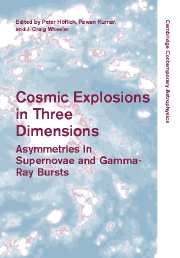Book contents
- Frontmatter
- Contents
- Part I Introduction
- Part II Supernovae: Observations Today
- 2 Supernova explosions: lessons from spectropolarimetry
- 3 Spectropolarimetric observations of supernovae
- 4 Observed and physical properties of Type II plateau supernovae
- 5 SN 1997B and the different types of Type Ic supernovae
- 6 Near-infrared spectroscopy of stripped-envelope supernovae
- 7 Morphology of supernova remnants
- 8 The evolution of supernovae in the winds of massive stars
- 9 Types for the galactic supernovae
- Part III Theory of Thermonuclear Supernovae
- Part IV Theory of Core Collapse Supernovae
- Part V Magnetars, N-Stars, Pulsars
- Part VI Gamma-ray Bursts
- Part VII Conference Summary
- References
9 - Types for the galactic supernovae
Published online by Cambridge University Press: 11 August 2009
- Frontmatter
- Contents
- Part I Introduction
- Part II Supernovae: Observations Today
- 2 Supernova explosions: lessons from spectropolarimetry
- 3 Spectropolarimetric observations of supernovae
- 4 Observed and physical properties of Type II plateau supernovae
- 5 SN 1997B and the different types of Type Ic supernovae
- 6 Near-infrared spectroscopy of stripped-envelope supernovae
- 7 Morphology of supernova remnants
- 8 The evolution of supernovae in the winds of massive stars
- 9 Types for the galactic supernovae
- Part III Theory of Thermonuclear Supernovae
- Part IV Theory of Core Collapse Supernovae
- Part V Magnetars, N-Stars, Pulsars
- Part VI Gamma-ray Bursts
- Part VII Conference Summary
- References
Summary
Abstract
The six galactic supernovae within the last millennium are critical to all work on the relationships between supernovae and their remnants. Yet this field has been dogged by controversy and discarded arguments. Even during the Wheeler Symposium, we had successive speakers give different type assignments to individual events. In an effort to at least define the confusion, I have polled a group of leading experts as to their current thinking on the types for each of the historical events. This complements a similar poll made a decade ago. We must realize that these results are not voting-on-the-truth, but is rather an expression of community opinion. The recent poll has the following results. SN1006 is universally agreed to be a Type Ia event. SN1054 (the Crab) is puzzling in many ways, but it must be from some sort of a core collapse event. SN1181 is thought to be a core collapse event primarily on the basis of its remnant being a plerion like the Crab. SN1572 (Tycho's) is agreed to be a Type Ia event. SN1604 (Kepler's) has no consensus, with all types being claimed and denied. Cas A is unanimously agreed to not be a Type Ia event, but after that all possibilities find their champions.
The polls
The six galactic supernovae within the last millennium (SN1006, SN1054, SN1181, SN1572, SN1604, and Cas A) all have very well observed remnants. A key question for understanding these remnants is the type of the original explosion.
- Type
- Chapter
- Information
- Cosmic Explosions in Three DimensionsAsymmetries in Supernovae and Gamma-Ray Bursts, pp. 81 - 84Publisher: Cambridge University PressPrint publication year: 2004

